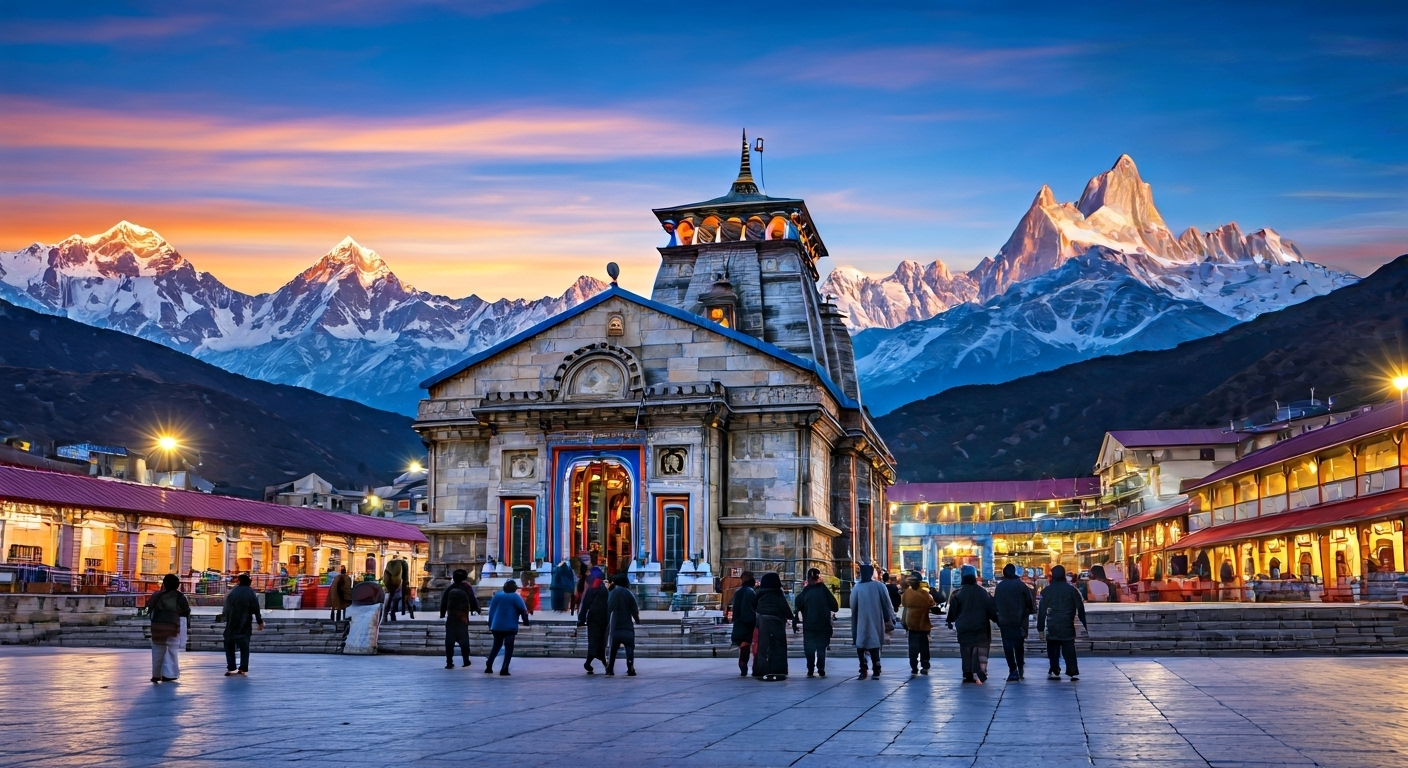
History and Significance of Kedarnath Temple
Kedarnath Temple, nestled in the heights of Uttarakhand, holds a revered place in India’s spiritual legacy. Recognized as one of the twelve Jyotirlingas, it is a vital destination for followers of Lord Shiva and a prominent stop on the sacred Char Dham Yatra.
As the highest among the Panch Kedar shrines, Kedarnath is not just a marvel of ancient stone architecture—it’s a symbol of divine penance and forgiveness. According to Hindu legend, the Pandava brothers built the temple after the Mahabharata war, seeking atonement for the bloodshed they had caused. Their devotion transformed this Himalayan site into a gateway for moksha—liberation from the cycle of rebirth.
The Kashi Kedara Mahatmya, an ancient scripture, beautifully captures its sanctity:
“The crop of liberation grows here.”
These words echo the belief that every step toward Kedarnath is a step closer to spiritual awakening.
The Journey to Kedarnath: What Every Pilgrim Should Know
Embarking on the Kedarnath Yatra is both a profound spiritual calling and a test of physical strength. The pilgrimage typically begins from Rishikesh or Haridwar, slowly climbing into the Himalayan heights toward Kedarnath Temple, perched at an elevation of 3,583 meters.
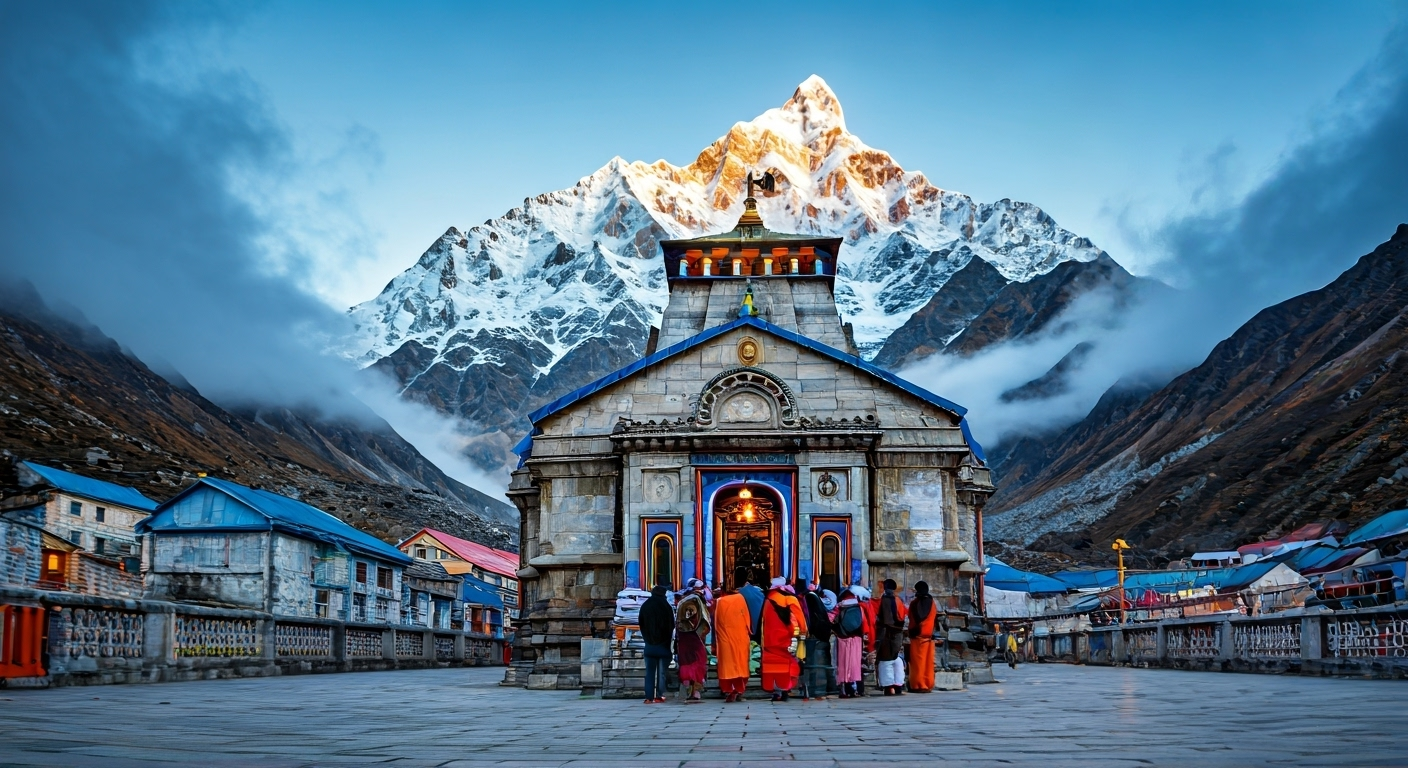
Reaching Gaurikund – The Trek Base
The motorable route ends at Gaurikund, the official starting point of the trek. From here, devotees must cover a distance of 16 to 18 kilometers to reach the temple. The journey offers stunning Himalayan views but also poses a significant challenge due to rugged terrain and high altitude.
Trekking & Travel Options
Depending on your stamina and comfort, there are several ways to complete the ascent:
- On Foot – Ideal for those seeking a deeply immersive spiritual experience. Trek time ranges from 6 to 10 hours, depending on pace and weather.
- Ponies & Palanquins (Palkis) – Readily available for those who prefer or need assistance, especially elderly pilgrims.
- Helicopter Services – Available from Phata, Sersi, Sitapur, and Guptkashi, this option dramatically reduces travel time but must be booked in advance due to high demand.
Trek Difficulty & Preparation
The Kedarnath route is rated moderate to difficult, mainly because of:
- Thin air at high altitude
- Steep, uneven, and rocky stretches
- Unpredictable weather, including sudden rain or snow

Essential Tips Before You Go
Book ponies/palkis or helicopters ahead of time, especially in peak season (May–June & Sept–Oct).
Maintain good physical fitness through walking or cardio workouts weeks before your trip.
Carry layered warm clothing, rain protection, and basic first aid.
Acclimatize gradually to avoid altitude sickness—stay overnight in Guptkashi, Sitapur, or Sonprayag if needed.
Stay hydrated, avoid heavy meals before the trek, and listen to your body.
Mythological stories and legends associated with Kedarnath Temple
The origin of Kedarnath Temple is deeply entwined with the epic aftermath of the Mahabharata. After the devastating Kurukshetra war, the Pandava brothers, overwhelmed by guilt for the bloodshed, sought the blessings and forgiveness of Lord Shiva to cleanse their sins.
However, Shiva, unwilling to grant pardon so easily, chose to avoid the Pandavas by disguising himself as a buffalo and retreating into the remote Garhwal Himalayas. Determined, the Pandavas followed him to this rugged region. It was Bhima, the second eldest, who finally spotted the disguised deity grazing among the mountains.
As Bhima tried to capture the buffalo, it is said that Shiva vanished into the earth. Different parts of his divine form then resurfaced at five separate locations, now known collectively as the Panch Kedar:
- Kedarnath – The hump appeared here, becoming the central deity of the Kedarnath Temple.
- Tungnath – His arms manifested at this site.
- Rudranath – The face emerged here.
- Madhyamaheshwar – His navel rose from this ground.
- Kalpeshwar – His matted hair (jata) appeared here.
These five sacred temples form a unique spiritual trail through Uttarakhand’s mountains, each representing a divine fragment of Shiva’s buffalo form.
The Kedarnath shrine, built at the site of the hump, houses a triangular-shaped Jyotirlinga, symbolizing the Lord’s celestial presence. The tale reflects not only Lord Shiva’s mysterious nature but also the depth of devotion and perseverance required for true spiritual liberation.
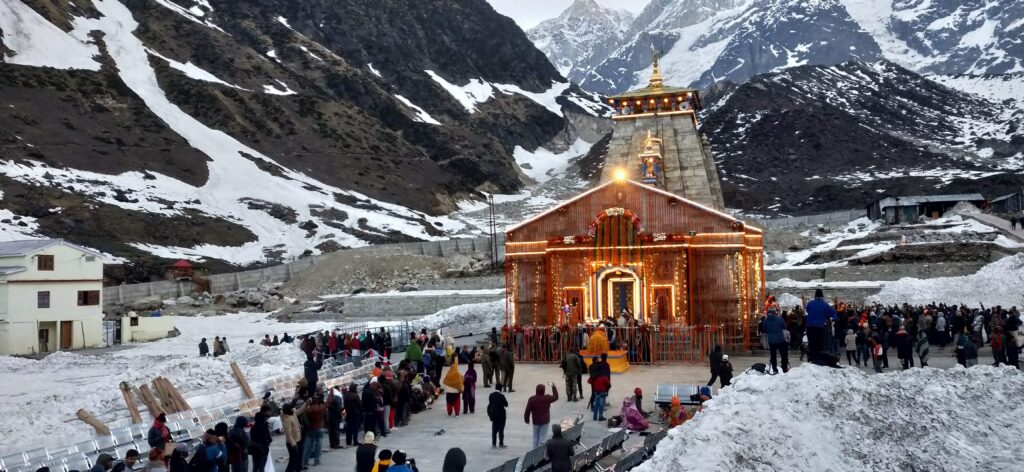
Important Dates & Registration Details for Kedarnath Yatra
The Kedarnath Yatra operates on a well-defined schedule each year, ensuring the safety, comfort, and smooth flow of thousands of pilgrims. Registration is mandatory for all visitors, whether you’re trekking or opting for helicopter services.
The temple opens its doors in early May and closes by late October, aligning with the summer season and favorable weather conditions in the Himalayas.
Below is the official 2025 Kedarnath Yatra timeline to help you plan ahead:
| Step / Item | Dates / Details |
|---|---|
| Registration Opens | 11 March 2025 |
| Temple Opening Date | 2 May 2025 |
| Temple Closing Date | 23 October 2025 |
| Last Motorable Point | Gaurikund |
| Online Registration | Available via Uttarakhand Tourism Portal and Char Dham E-Pass Portal |
| Offline Registration | Counters available at Dehradun, Haridwar, Rishikesh, Guptkashi, and Sonprayag |
✅ Pro Tips:
Always carry your registration confirmation and valid ID proof during the yatra.
Register early to secure your desired darshan date and mode of transport.
Helicopter bookings and palki/pony services get reserved quickly during peak periods (May–June, September).
How to Check Your Kedarnath Registration Status 2025?
Once you have completed your registration for Kedarnath Dham in 2025, it is crucial to keep an eye on your registration status. This ensures you are cleared for entry and helps you manage your travel dates efficiently. The process is simple and can be done entirely online or with the help of support centres.
To check your registration status, follow these steps:
| Method | Steps/Details |
|---|---|
| Online Portal | Log into the official Uttarakhand Tourism/Char Dham E-Pass portal with your credentials. |
| Email Confirmation | Check your email inbox for a registration confirmation and status update. |
| Helpline | Contact the designated helpline or visit a local registration centre if you face issues. |
| Offline Centres | Visit counters at Dehradun, Haridwar, Rishikesh, Guptkashi, or Sonprayag for in-person help. |
Always carry a printed or digital copy of your confirmation when travelling—this is checked at multiple points before you reach the temple.
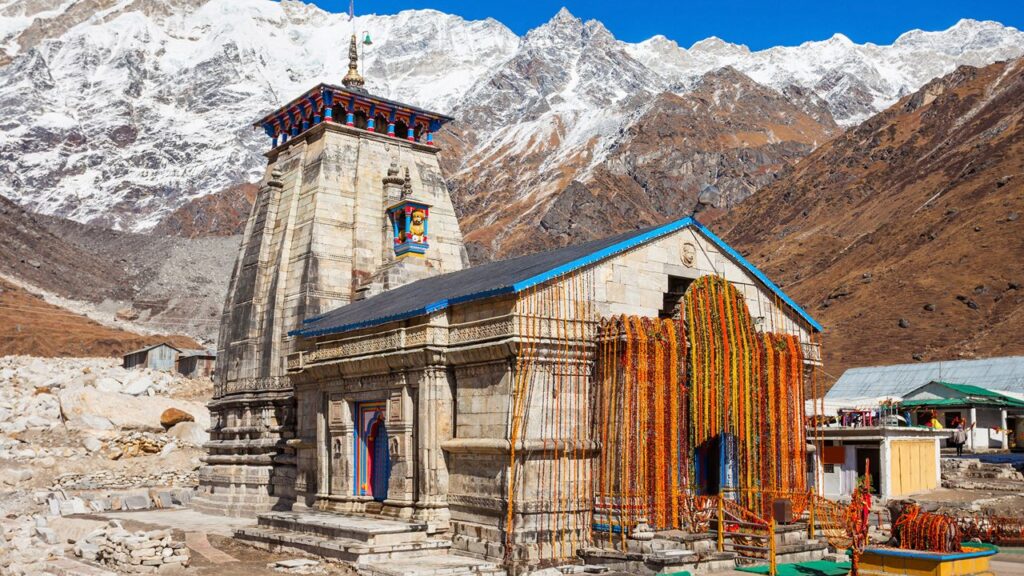
Exploring the Surrounding Areas and Other Activities during Your Yatra
While the sacred Kedarnath Temple is the spiritual heart of your journey, the surrounding region offers a wealth of natural beauty, cultural charm, and mythological sites that make the yatra even more meaningful.
Scenic & Sacred Spots to Explore
- Rudraprayag – Located at the confluence of the Alaknanda and Mandakini rivers, this picturesque town is perfect for a peaceful stopover. The meeting of the two rivers is considered deeply auspicious and offers breathtaking views of the lower Himalayas.
- Sonprayag – A revered spot on the yatra route, Sonprayag is believed to be the place where Lord Shiva and Goddess Parvati were united. The town is surrounded by misty mountains and marks a key junction before reaching Gaurikund.
- Gaurikund – Known for its natural hot springs and religious significance, Gaurikund is where Goddess Parvati is believed to have meditated. Pilgrims often take a dip here before beginning the final stretch to Kedarnath.
- Triyuginarayan Temple – Just a short detour from Sonprayag, this temple marks the mythical wedding site of Shiva and Parvati. A continuously burning sacred fire (Akhand Dhuni) is believed to have witnessed their union.
Other Activities to Enrich Your Yatra
Local food tasting, including warm pahadi dishes at dhabas and guest houses.
Riverside walks along the Mandakini River, soaking in serene landscapes and local village life.
Temple visits to lesser-known shrines en route, offering quieter moments of reflection.
Spiritual photography of snow-draped peaks, flowing rivers, and Himalayan wildlife.
The Holy City of Kedarnath
Kedarnath is more than just a pilgrimage—it’s a living, breathing town that thrives on devotion, spirituality, and sheer resilience. Cradled in the mighty Himalayas, it stands as a vital part of both the revered Char Dham Yatra and the sacred Panch Kedar circuit, attracting thousands of pilgrims and spiritual travelers every year.
The centerpiece of the town is the iconic Kedarnath Temple, built in a timeless North Indian Himalayan architectural style. Its sturdy stone construction has withstood centuries of harsh weather and even natural disasters, symbolizing unwavering faith in the divine.
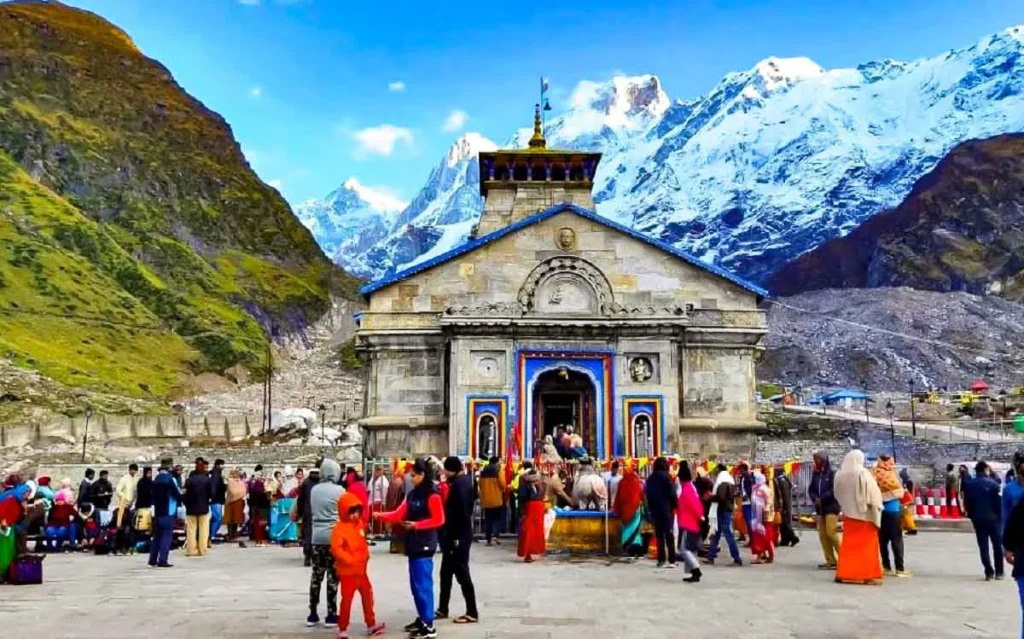
A City Wrapped in Devotion
As you step into Kedarnath, you’re met with:
- Towering peaks that seem to touch the sky
- The gentle roar of the Mandakini River
- Streets lined with small shrines, dharamshalas, and prayer flags
- A community of priests, pilgrims, porters, and monks, all revolving around the spiritual pulse of the temple
Whether you’re attending the evening aarti, joining a religious procession, or simply soaking in the mountain silence, every moment in Kedarnath is filled with an unmistakable energy of devotion.
Essential Tips for a Safe & Comfortable Kedarnath Yatra
The Kedarnath Yatra is a deeply spiritual experience, but its high altitude, steep terrain, and unpredictable mountain weather require thoughtful preparation. Prioritizing your health, comfort, and safety will ensure a smoother journey and allow you to focus on the spiritual essence of the pilgrimage.
Prepare for Altitude and Climate
- Acclimatize Properly: Spend at least 24 hours at a lower altitude (e.g., Rishikesh, Haridwar, Guptkashi) before ascending further. This helps your body adjust to thinner air.
- Check Weather Forecasts: Always track the latest weather updates before and during the trip. Postpone trekking during heavy rain or snowfall.
Packing Essentials
- Warm Layers: Carry thermal innerwear, insulated jackets, gloves, and woolen caps. Nights are cold, even in summer.
- Rain Gear: Pack a waterproof jacket, poncho, and bag covers in case of unexpected showers.
- Footwear: Use sturdy, water-resistant trekking shoes with good grip to avoid slips on rocky or wet paths.
- Health Kit: Bring personal medication along with altitude sickness pills, pain relievers, and basic first aid supplies.
Accommodation & Travel Planning
- Book Early: Pre-book hotels, guesthouses, or dharamshalas to avoid last-minute hassles, especially during peak season.
- Avoid Late Treks: Do not start the trek after 2 PM. It gets colder and riskier as daylight fades.
- Travel Light: Carry only what’s necessary. Porters, mules, and palkis are available if needed.
Bonus Tip:
Carry a small torch, power bank, extra batteries, identity proof, and printed registration confirmation at all times.

Things to Do in and Around Kedarnath
While the Kedarnath Temple is undoubtedly the spiritual centerpiece, the surrounding region offers a rich mix of nature, culture, and sacred experiences that make your yatra truly unforgettable.
Whether you’re seeking peace by the river, local exploration, or divine rituals, Kedarnath has more to offer than meets the eye.
1. Unwind by the Mandakini River
Let the soothing sound of the Mandakini River wash over you. Sit by its banks and reflect in the lap of the Himalayas — a perfect moment of calm after your trek.
2. Stay in Unique Local Accommodations
From basic dharamshalas to modern lodges and hotels, Kedarnath offers various accommodation options. You can also experience tented camps, offering a rustic, nature-immersive stay.
Tip: Always pre-book your stay during the May–October season.
3. Explore Local Markets
Stroll through small mountain bazaars for:
- Spiritual souvenirs like rudraksha malas and framed temple photos
- Local snacks and traditional Garhwali food
- Warm woolens and handmade goods from the region
4. Attend Temple Aartis
Don’t miss the early morning (Mangala Aarti) or evening aarti at the Kedarnath Temple. These ceremonies are filled with chanting, bells, and divine energy that make the entire experience feel surreal.

5. Extend Your Pilgrimage
Plan day trips or post-yatra visits to:
Badrinath & Rishikesh – If time allows, continue your Char Dham journey or relax in yoga capital Rishikeshnath even more fulfilling.
Triyuginarayan Temple – The legendary wedding site of Lord Shiva and Parvati
Guptkashi & Sonprayag – Spiritual towns on the way back
2013 floods
The 2013 flash floods in Kedarnath marked one of the most catastrophic natural disasters in modern Indian history. Triggered by unusually intense monsoon rains, cloudbursts led to severe flooding and massive landslides across Uttarakhand. The Mandakini River overflowed violently, sweeping away homes, roads, and lives in its path.
The sacred town of Kedarnath was among the hardest hit. Entire stretches of infrastructure vanished, and hundreds of pilgrims and locals tragically lost their lives. The disaster left a haunting silence in what was once a bustling spiritual haven.
Yet, in this darkness, a symbol of divine intervention emerged — a massive boulder that rolled down from the mountains and came to rest just behind the Kedarnath Temple, shielding it from the worst of the flood’s fury. This stone, now worshipped as “Bheem Shila,” is revered by devotees as the force that miraculously saved the temple.
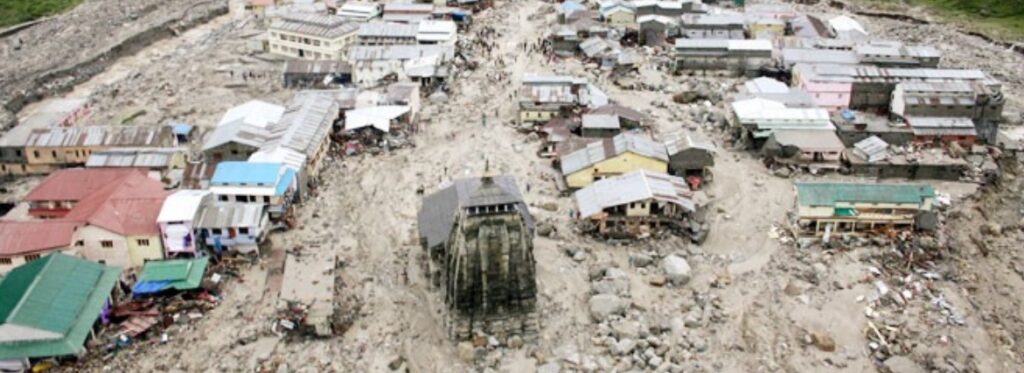
Stories of Resilience: Pilgrims’ Experiences in Kedarnath
In the aftermath, tales of courage and survival began to surface. Pilgrims who were trapped during the flood recounted harrowing experiences — some sheltered inside the temple for hours or even days, surrounded by rising water and uncertainty.
Rescue teams, including Indian Army, ITBP, and local volunteers, launched one of the country’s largest-ever relief efforts, often risking their lives to save others stranded in treacherous terrain.
A commonly shared story speaks of “God’s Rock” — the Bheem Shila — as a divine protector. For many, it became more than just a rock; it symbolized the indestructibility of faith and the spiritual strength that defines the Kedarnath Yatra.
As Swami Vivekananda once said:
“Strength is life, weakness is death.”
This spirit lived on through the survivors, the rescuers, and the pilgrims who returned in the following years with renewed faith.
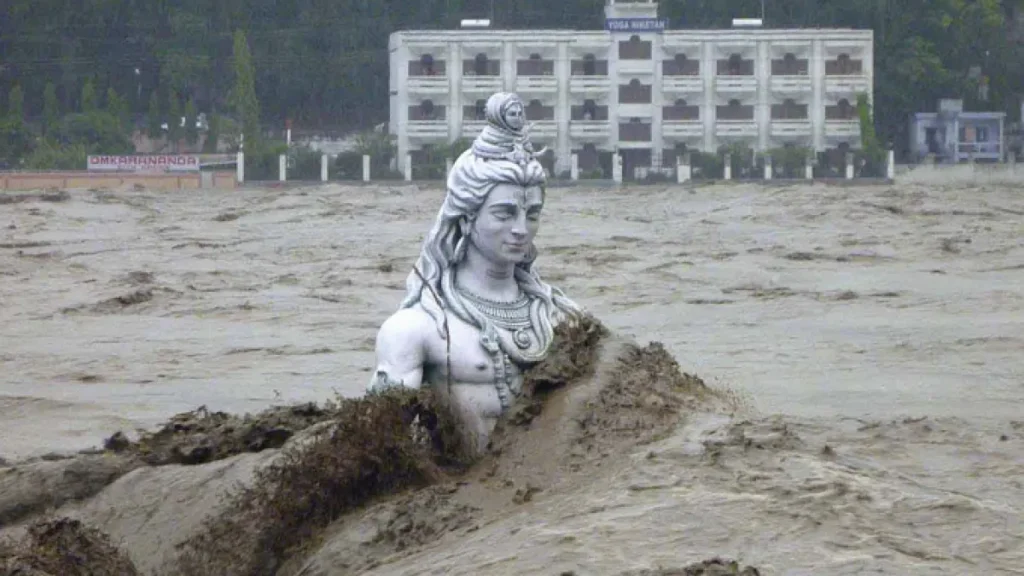
Kedarnath Today – Rising from the Rubble
Since the disaster, Kedarnath has undergone massive reconstruction and modernization. Safer roads, better infrastructure, and stricter safety protocols have been put in place to protect both the temple and its pilgrims. Yet, the emotional imprint of 2013 continues to inspire every traveler who sets foot on this sacred land.
Today, Kedarnath stands not just as a temple, but as a symbol of hope, faith, and resilience — a place where devotion withstood disaster, and where spiritual journeys continue stronger than ever.
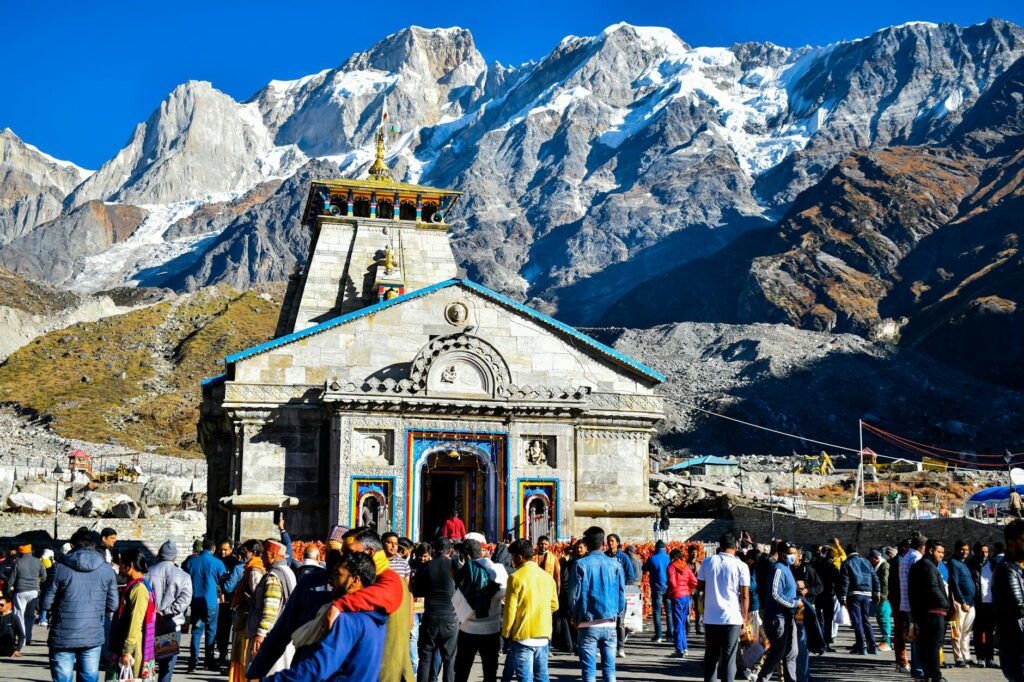
Frequently Asked Questions
Why is Bheem Shila considered sacred after the 2013 floods?
Bheem Shila, a massive boulder that rolled down from the mountain, diverted floodwaters and protected Kedarnath Temple from being destroyed. Devotees now worship it as a divine protector, symbolizing Lord Shiva’s grace.
What changes were made to Kedarnath’s infrastructure after the floods?
Post-2013, the government rebuilt the town with stronger embankments, helipads, wider paths, and early-warning systems, making it safer and more accessible without disturbing the sanctity of the site.
Is there internet or mobile connectivity in Kedarnath now?
Yes, limited connectivity is available near the temple via BSNL and Jio networks, but signal strength may vary. Most people rely on offline maps and printed registrations while trekking.
How has the local community adapted since the 2013 disaster?
Locals have shown remarkable resilience, rebuilding guesthouses, dhabas, and businesses. Many are now involved in tourism services, offering authentic insights and warm hospitality to pilgrims.
What rituals are unique to Kedarnath compared to other Char Dham sites?
The Abhishekam of the Jyotirlinga using water from the Mandakini River and the pre-dawn aarti amidst Himalayan silence are spiritually powerful experiences unique to Kedarnath.
Can non-Hindus visit Kedarnath Temple?
Yes, the temple is open to all faiths and nationalities. Visitors are expected to show respect for local customs, dress modestly, and follow temple etiquette.
Is it possible to visit Kedarnath solo or without a group?
Yes. While group travel is common, solo yatris often complete the trek on their own. However, it’s recommended to register in advance, carry essentials, and avoid off-season travel for safety.
What kind of food is available near the temple?
Expect simple vegetarian meals like dal-rice, roti-sabzi, and tea. Food is cooked fresh and available at langars, local dhabas, and camps. Non-veg and alcohol are strictly prohibited.
Is Kedarnath safe for elderly or differently-abled pilgrims?
Yes, with palki, pony, and helicopter services, it is possible. However, due to high altitude and thin oxygen levels, a medical consultation is highly advised before planning the trip.
Are there eco-conscious or sustainable practices followed in Kedarnath?
Yes, the government and NGOs have launched initiatives like plastic bans, bio-toilets, solar energy use, and strict garbage disposal guidelines to preserve the fragile Himalayan ecosystem.


